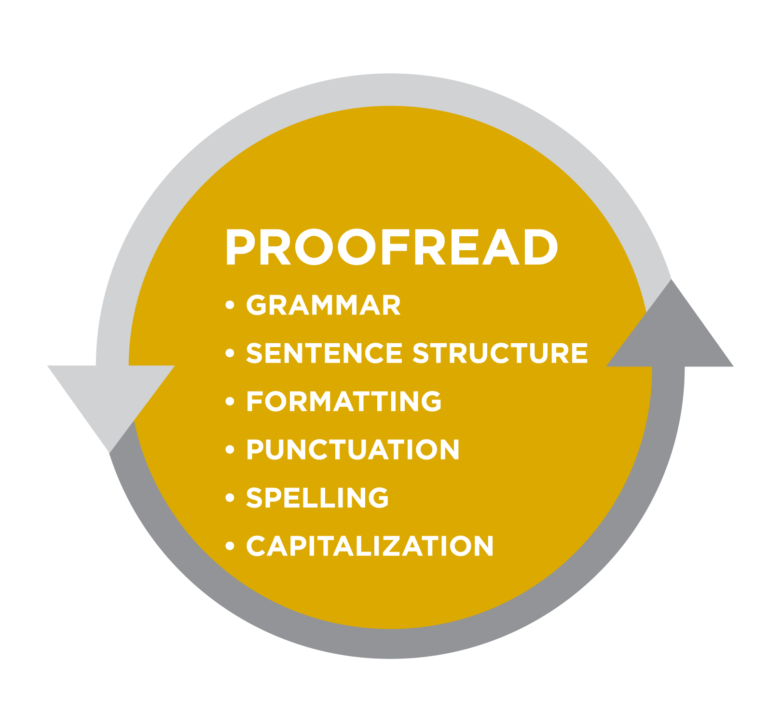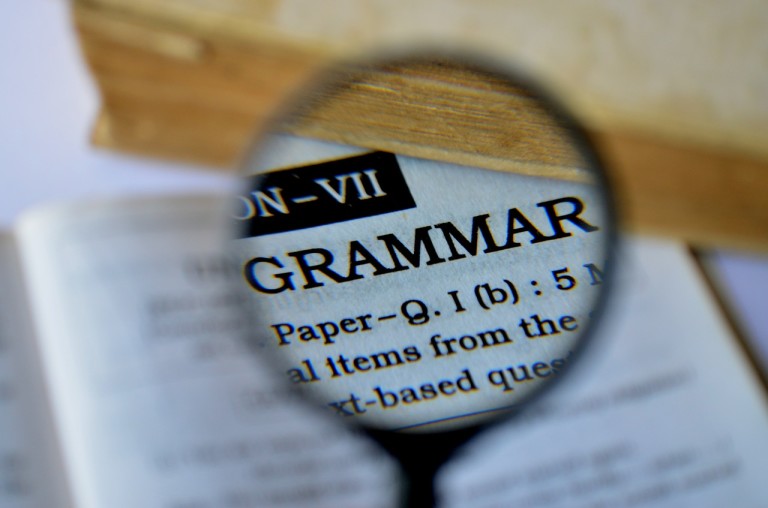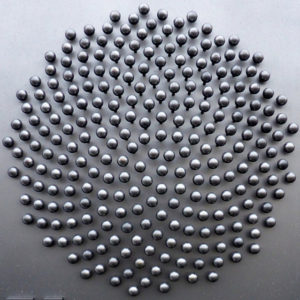3.8: Proofreading
- Page ID
- 5291
- Identify lower order concerns for revision
- Identify strategies for improving sentence clarity
- Identify strategies for recognizing potential grammatical issues in a draft
- Identify strategies for recognizing potential spelling issues in a draft
- Identify strategies for recognizing potential punctuation issues in a draft

Figure \(\PageIndex{1}\)
Proofreading is the final dust-and-polish pass-through of your writing. Though it’s the last step of writing, it’s what will make the first impression people have of your work.
John Green, author of The Fault in Our Stars, walks through some of his favorite typos from history in the video below. Each of these fundamentally changed the way people read the works in question. Proofreading (or a lack thereof) can have lasting impact!
Lower Order Concerns
What to Look for in the Later Proofreading Pass(es): Lower-Order Concerns
Once you have fully addressed the higher-order concerns with an essay draft, you can focus on more local fixes or lower-order concerns. Lower-order concerns include writing style, wording, typos, and grammar issues.

Figure \(\PageIndex{2}\)
Yes, it’s true: grammar is a lower-order concern! Even though students are often very concerned that their grammar needs to be fixed, it is actually more important to focus on the quality of your ideas and the logic of how they are presented first. That’s not to say you shouldn’t worry about grammar; it’s just that you shouldn’t make it a main focus until closer to the end of the writing process.
Some typical lower-order concerns are listed below, along with some questions that can help you recognize aspects in need of revision:
- Style:
- Are you using an appropriate tone?
- Are you following the conventions that are typical of your discipline?
- Are you using the required style for formatting?
- Wording:
- Are you always picking the word that has the precise meaning you want?
- Are there any places where your wording is confusing or where your sentences are long and hard to follow?
- Are there any awkward phrases?
- Are you writing as simply and concisely as possible?
- Are there any redundant words or sentences that should be removed?
- Grammar:
- Do you have any sentence fragments or run-on sentences?
- Are your subjects and verbs in agreement?
- Are you handling your plurals and possessives correctly?
- Are there any punctuation errors?
- Typos:
- Are there missing words?
- Are any words misspelled (be especially careful to watch out for words that spell-check won’t catch, for example typing “can” when you meant “van”)?
- Are there any extra spaces that need to be removed?
Cleaning up these local issues is the final stage in the writing process. Think of this as polishing up your writing, so that the quality of your prose matches the quality of your ideas.
Other Tips for Proofreading

Figure \(\PageIndex{3}\)
- Always read slowly and carefully when proofreading. Don’t rush! If you try to go too fast, you will probably miss errors you would otherwise catch.
- Read your paper out loud. This can be very helpful for catching typos, missing words, awkward phrasings, and overly long or confusing sentences.
- Pretend you are the reader, not the author of the paper. Try to look at what you wrote from the perspective of someone who does not know all the things you know. Would a reasonably intelligent audience be able to understand your prose and be convinced by your argument?
- Keep track of any errors you consistently make (within a single paper or in multiple papers).
- Get feedback on your paper from your teacher, a classmate or friend, a tutor, or all of the above.
The Change-Up Method
The following video walks us through a simple but effective way to proofread our writing. It’s helpful to see that even professional writers and editors make mistakes in their drafts that need to be corrected before sharing with the world.
A transcript for this video can be downloaded here (.docx file).
The steps include
- changing the font style and size
- making the line spacing bigger
- reading the text backwards, from last sentence to first sentence
Proofreading Strategies
Below, you’ll see a long list of potential items to look for in the proofreading process. Because everyone has a unique writing style, some of these items are much more likely to apply to you (and be helpful for you to consider) than others.
As you continue to write papers and get feedback on them in college, make note of the concerns that show up in your writing again and again. Make your own customized list of proofreading tips, to save time in the future.
Some suggestions to get you started–again, not all of these will apply to each paper, each time.

Figure \(\PageIndex{4}\)
Editing for Language
With language, the overall question is whether you are using the most accurate language possible to describe your ideas. Your reader will have an easier time understanding what you want to say if you’re precise. Be sure to check for the following.
- Pronoun clarity: Make sure it’s clear what each “it,” “he,” and “she” refers to.
- Precise vocabulary: Make sure every word means what you intend it to mean. Use a dictionary to confirm the meaning of any word about which you are unsure.
- Defined terms: When using terms specific to your topic, make sure you define them for your readers who may not be familiar with them. If that makes the paragraph too bulky, consider using a different term.
- Properly placed modifiers: Make sure your reader can clearly discern what each adjective and adverb is meant to describe.
- Hyperbole: See if you can eradicate words like “amazing” and “gigantic” in favor of more precise descriptions. Also examine each use of the word “very” and see if you can find a more precise adjective that doesn’t require its use.
Finally, pay attention to wordiness. Writing that is clean, precise, and simple will always sound best.
Editing for Sentence Construction
If you want to make everything easy for your audience to read and understand, start by simplifying your sentences. If you think a sentence is too complicated, rephrase it so that it is easier to read, or break it into two sentences. Clear doesn’t have to mean boring.

Figure \(\PageIndex{5}\)
Consider how balanced your sentences are within a paragraph. You don’t want every sentence to have identical length and structure or to begin the same way. Instead, vary your sentence style.
This is also the time to add transitions between phrases and sentences that aren’t connected smoothly to each other. You don’t need to introduce every sentence with “then,” “however,” or “because.” Using these words judiciously, though, will help your reader see logical connections between the different steps of your argument.
Suggestions While Proofreading
- Remove unnecessary words such including that, very, just, so, and actually.
- Avoid the passive voice. Rewrite sentences that include am, is, was, were, be, being, and been so that the sentence reads in the active voice.
- Don’t end sentences with a preposition. For example, don’t end sentences with these words: in, for, at, with, by, and from.
- Is the content in past, present, or future tense? Do a scan to make sure you use the same tense from start to finish.
- Are you writing in first, second, or third person? Do a scan to make sure you use a consistent voice throughout. Generally, avoid second person pronouns–“you”–throughout an essay, unless you have specific reasons to in the assignment. Use the “find” feature in your word processor to locate any that may have slipped in. Likewise, only use first person pronouns–“I,” “me,” “we,” etc.,–if your assignment calls for it.
- Have you used one space after each sentence or two spaces? Double check for consistency.
- Run spell check, but also check for commonly misspelled words that your spell check might not pick up. Here’s a quick list:
- To/ Too/ Two
- Than/ Then
- Trail/ Trial
- Were/ Where/ We’re
- It’s/ Its
- Lose/ Loose
- Complement/ Compliment
- Their/ There/ They’re
- Compliant/ Complaint
- What words do you commonly misspell?
- Eliminate words you overuse. Keep a running list near your workspace that notes words you rely heavily on, and edit use the “Find” feature of your word processor to search for them while editing.


